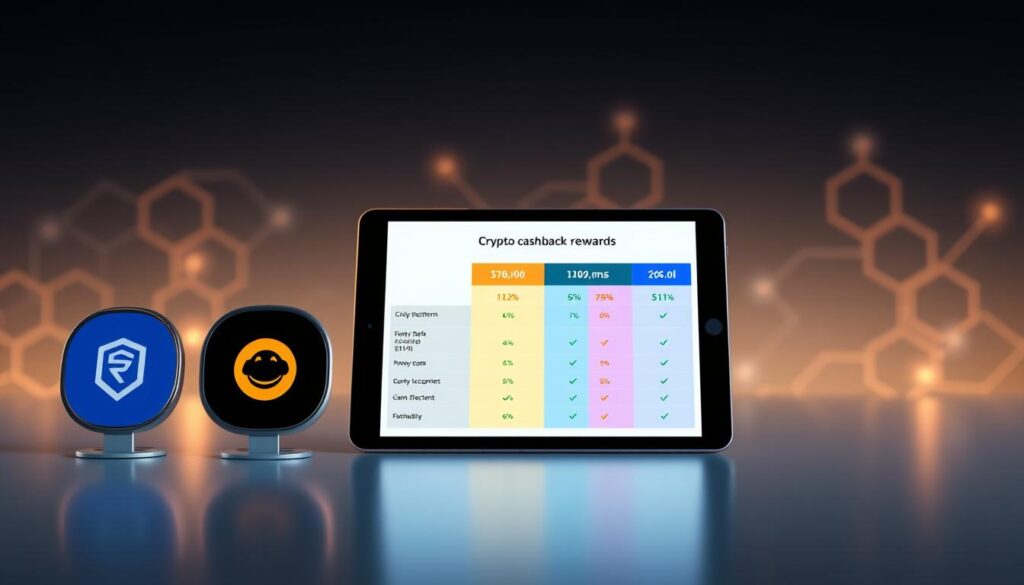Now Reading: How to Boost Your Crypto Staking Rewards
- 01
How to Boost Your Crypto Staking Rewards
How to Boost Your Crypto Staking Rewards

Crypto staking rewards let you earn money without much work by helping blockchain networks. This guide shows you how to get the most out of it. Whether you’re just starting or want to improve, learn about the best ways to increase your earnings.
Staking has become a big way for crypto owners to make money. Platforms like Ethereum 2.0, Solana, and Cardano offer good returns. By keeping up with blockchain changes, you can make your investments work better. Find out how to boost your rewards without risking your money.
Key Takeaways
- Staking unlocks opportunities to earn passive income through blockchain participation.
- Maximizing crypto staking rewards requires evaluating risk, reward rates, and liquidity needs.
- Top protocols now offer double-digit annual percentage yields for eligible assets.
- Strategic choices between short-term gains and long-term locking periods impact overall returns.
- 2023 innovations in liquid staking and cross-chain options expand earning potential while retaining asset control.
Understanding Crypto Staking Rewards and Their Potential
Cryptocurrency staking is a way to earn money by helping blockchain networks. You hold digital assets in a wallet to help validate transactions. This method is different from mining because it uses token ownership for security, not just power.
What Is Cryptocurrency Staking?
Staking means locking tokens in a wallet or platform. These tokens help validators, who are picked randomly to check transactions. For example, Ethereum uses stakers to secure its network.
Stakers earn rewards based on how much they stake and their activity. The more you stake, the more you can earn.
How Staking Differs from Mining
- Mining uses energy-intensive hardware to solve puzzles
- Staking requires holding tokens instead of specialized equipment
- PoS networks like Cardano and Solana use staking for consensus
Staking is more accessible and energy-friendly than Bitcoin mining.
The Economics Behind Staking Rewards
Reward rates depend on things like APY and network inflation. For example, a 5% APY on $10,000 staked means $500 a year. But, higher rewards might mean longer lock-ups.
Protocols like Polkadot adjust rates to keep the network secure and encourage people to participate.
Getting Started with Crypto Staking: Essential Requirements
To start your crypto staking journey, you need to meet certain requirements. Follow these steps to prepare securely and effectively:
- Make sure you have reliable hardware and a stable internet connection. Use a desktop computer with wallets like MetaMask or Trust Wallet to manage your staking tokens.
- Check the minimum token requirements. For example, Ethereum 2.0 needs 32 ETH per validator. Other protocols might allow smaller stakes. Not having enough tokens can lead to penalties.
- Look at network-specific rules. Each blockchain has its own rules, like uptime requirements or software versions. Ignoring these can reduce your staking benefits or cause fees.
- Follow security best practices. Store your assets in hardware wallets like Ledger. Enable two-factor authentication and back up your recovery phrases regularly to protect your staking tokens.
Security is crucial. Use encrypted cold storage for large amounts and avoid leaving funds in exchange wallets. Many staking benefits go beyond just returns, like getting to vote on protocol changes. Always check the minimum tokens needed for your chosen platform and keep up with updates to stay eligible. Choose platforms with clear documentation to make setup easier and get the most rewards in the long run.
Choosing the Right Cryptocurrencies for Maximum Staking Returns
Choosing the best staking tokens means finding a balance between rewards and risks. This guide will show you how to pick the top ones and avoid mistakes.
Top High-Yield Staking Tokens
Here are some leading staking tokens with great records:
- SOL (Solana): 8-12% APY, fast transactions
- ADA (Cardano: 5-9% APY, energy-efficient
- XTZ (Tezos: 4-7% APY, established DeFi ecosystem
These tokens offer steady returns but you need to hold them for 6-12 months.
Evaluating Reward Rates vs. Risk
Look at the annual percentage yields (APYs) and consider three risks:
- Market volatility affecting token value
- Protocol security vulnerabilities
- Inflation rates impacting long-term rewards
Higher APYs often go with newer projects. Look for audited smart contracts and clear governance.
Emerging Staking Opportunities in 2023
New players like staking opportunities in Polkadot (DOT) and Algorand (ALGO) offer 6-10% APY. They also support cross-chain compatibility. These protocols let you explore different scaling solutions.

Always check project whitepapers and community growth before investing. Use platforms like StakingRewards.com for up-to-date comparisons.
The Relationship Between Lock-up Periods and Reward Rates
Many protocols tie crypto staking rewards to lock-up periods. Longer commitments can mean higher staking incentives. Solana and Cardano reward users for locking tokens for longer times. But, shorter lock-ups might give quicker access to funds, though with lower yields.
It’s all about finding the right balance. This ensures your strategy fits your liquidity needs.
Short-term vs. Long-term Staking Strategies
- Short-term (3–6 months): Great for those who value flexibility. Returns are lower, but funds are easy to access during market changes.
- Long-term (1+ years): Offers higher yields but locks up capital for a long time. Best for those who can wait and don’t need quick access to funds.
Calculating the Time Value of Locked Tokens
Stakers need to think about what they could have done with their money. For example, locking $10,000 for two years at 8% APY could earn $1,664. But, compare this to other investments like DeFi pools or liquidity mining.
Don’t forget about the risks of impermanent loss in long-term strategies. Use a formula like Time Value = (Annualized Reward Rate × Lock Duration) – Fees to figure out your net gains.
Compound Staking: Reinvesting Your Rewards for Exponential Growth
Compound staking turns small rewards into big growth. By putting earnings back in, your balance grows faster than before. This way, earn passive income strategies work even better.
This method makes annual returns grow bigger over time. It boosts staking benefits over years, not just months.
Let’s say you start with $1,000 and get a 10% return each year. In the first year, you earn $100. Then, you reinvest that $100, making it grow 10% on $1,100 the next year.
After five years, you’ll have $1,610.51. Without reinvesting, you’d have $1,500. It’s clear: reinvesting makes your money grow faster.
- Automatic compounding: Protocols like Tezos (XTZ) and Cosmos (ATOM) do the reinvesting for you. You just need to set it up once.
- Manual compounding: Sites like Stake Capital let you choose when to reinvest. This gives you control over your growth.
When to reinvest matters. Put money back in during high-yield times. But take it out when the market drops. Most experts say to use auto-compounding for stable coins and manual for volatile ones.
Choosing low-fee platforms helps keep more of your earnings. This way, you get the most out of your investments.
Compound staking is key for growing your crypto. Even small starts can become big portfolios. It’s perfect for long-term goals, making crypto a reliable source of earn passive income with little effort.
Leveraging Staking Pools to Increase Your Earnings
Staking pools let users combine resources to get better returns in blockchain staking. By joining forces, people can earn more without the big costs of solo staking. This way, they get a good balance of risk and reward, and more people can join top staking rewards platform opportunities.
Solo Staking vs. Pool Staking: Pros and Cons
Solo staking needs a lot of money and tech know-how, but you control your keys. Pools make it easier to start, with smaller amounts needed and risk spread out. Here’s a comparison:
- Minimum stakes: Pools take smaller deposits than solo staking.
- Reward consistency: Pools give out earnings often, solo staking depends on network events.
- Control: Pools share key management, but lower personal risks.

How to Spot Reliable Staking Pools
Look for pools with clear fees and a good track record. Check for security audits, community feedback, and follow blockchain staking rules. Sites like Origin Protocol show they handle liquidity and risk well. Always review how they handle withdrawals and how validators perform.
Minimizing Pool Fees
Compare fees across different platforms. Look for:
- Clear fee details (like transaction, performance, and exit fees).
- Pools with different prices for bigger investors.
- Platforms that offer fee discounts for long-term investors.
Choose staking rewards platform options that fit your investment time frame.
Advanced Techniques to Maximize Your Crypto Staking Rewards
Experienced stakers can increase their earnings with special tactics. They choose validators based on uptime and commission rates. This way, they get better crypto staking rewards. For example, Polkadot uses nominator set optimization. Stakers spread funds across validators to avoid penalties and get more payouts.
- Track Maximal Extractable Value (MEV) chances on networks like Ethereum. Validators can earn extra fees from building blocks.
- Try testnet staking for new protocols early. This way, you can get bonus rewards before the mainnet starts.
- Use analytics tools to join in during busy times. This boosts your staking chances.
Some projects offer different reward levels based on how much you stake. But, these strategies need constant checking of updates and validator performance. There are risks like slashing penalties or technical issues that need careful thought. Stakers should spread their investments across many networks to balance risks and rewards.
Always check the rules of each platform to avoid getting stuck in bad deals. These advanced methods are for those ready to learn the ins and outs of networks for better earnings.
The Role of Validators in the Staking Ecosystem
Validators are key in blockchain staking networks. They check transactions and create blocks. Their work keeps the network safe and helps share staking incentives. It’s important to see they do two main jobs: keeping things secure and earning rewards.
Becoming a Validator: Requirements and Benefits
To be a validator, you need to meet certain requirements. You’ll need good hardware, always be online, and know how blockchain works. For example, Ethereum’s proof-of-stake needs at least 32 ETH to start.
There are risks like losing money if you’re not always online or if you do something wrong. But, you can earn money from transaction fees and special tokens.
- Hardware: High-performance servers for real-time network participation
- Stake Size: Minimum holdings to qualify for validation rights
- Responsibilities: Monitoring network activity 24/7 to avoid slashing penalties
Selecting Validators for Delegated Staking
When choosing validators, look at clear metrics. Focus on nodes with:
- Uptime: Aim for 99.9%+ operational consistency
- Commission Rates: Compare fees charged by validators (typically 5–15%)
- Track Record: Check for prior slashing incidents or governance participation
Choosing wisely helps you get the best staking incentives while keeping risks low. Systems like Cardano’s Ouroboros and Solana’s proof-of-history reward good validators. This creates a good relationship between them and the network’s stability.
Liquid Staking: Maintaining Liquidity While Earning Rewards
Liquid staking is a game-changer in cryptocurrency staking. It lets holders keep control of their funds and still earn rewards. This way, users can trade, borrow, or lend without losing out on returns.
Top Liquid Staking Protocols
- Lido Finance: Dominates Ethereum staking with its stETH token, offering broad DeFi integration.
- Rocket Pool: Combines ETH staking with a minimum of 16 ETH, maintaining network security through decentralized nodes.
- Frax Finance: Expands into liquid staking with FXS tokens, linking yield farming opportunities.
Risks and Benefits of Liquid Staking Derivatives
Benefits: Users get instant liquidity and access to DeFi apps across chains. They also avoid market timing risks.
Risks: There are smart contract vulnerabilities and price issues (depegging). Users also rely on protocol governance decisions.
Staking tokens in liquid solutions might face centralization risks if one protocol gets too big.
It’s important to do your homework. Look at security audits, TVL, and past performance before picking a platform.
Cross-Chain Staking Strategies for Diversification
Staking across different blockchains opens up new staking opportunities. It also reduces the risk of relying on just one network. By using platforms like Ethereum, Solana, and Polkadot, users can enjoy various rewards and risks.
Spreading investments across chains helps smooth out market ups and downs. This way, stakers can manage risks better.
A good strategy mixes well-known networks with new ones. For instance, combining Ethereum with Polygon or Avalanche can balance stability and growth. Here are some key steps:
- Look at how different consensus mechanisms (like PoS) affect rewards
- Watch how different chains perform together
- Compare the minimum staking amounts and what’s needed to be a validator
Each chain offers different staking benefits. Tezos gives steady returns, while Cosmos helps with working across different networks. But, managing many chains can be complex.
Users need to keep track of balances, fees, and updates. Sites like StakingRewards.com help with this, but tracking taxes is still a challenge.
Diversifying staking wisely lets users grab unique chances without too much risk. Choosing chains with active developers and clear plans is key. This way, stakers can build strong, flexible portfolios that can handle changing markets.
Navigating the Risks of Staking: Slashing, Volatility, and Protocol Changes
Cryptocurrency staking can be very profitable, but it also comes with risks. People staking on blockchain need to know about penalties like slashing. They also face market swings and changes in protocols that can affect their rewards. This section will explain these challenges and how to handle them.
Understanding Slashing Penalties
Slashing happens when validators break network rules, losing their staked funds. On Ethereum, not being active enough can lead to penalties. Solana’s Proof-of-Stake network also has rules against double-signing.
In 2022, Cosmos saw validators lose 5% of their stakes for misconduct. Always pick reputable validators with good uptime to avoid these penalties.
Market Volatility Impact on Staking Returns
Even with high APYs, staking rewards can drop if the asset’s price falls. In 2022, staking $10k in SOL earned 8% APY but lost 60% of its value. Use tools like Staking Rewards’ charts to track price trends.
Pair staking with stop-loss orders or rebalancing strategies to protect against price drops.
Mitigating Risk with Portfolio Diversification
- Spread stakes across multiple validators on the same network
- Allocate funds to stable networks like Cardano and Polkadot alongside Ethereum
- Combine blockchain staking with non-staking assets like BTC or stablecoins
For example, a portfolio with 30% Solana, 30% Tezos, and 40% USD Coin can reduce risk. Check platforms like Stakehound for validator performance regularly.
Tax Implications of Earning Staking Rewards in the United States
Crypto staking rewards in the U.S. come with tax rules. The IRS sees these rewards as taxable income. This means you must report earn passive income from staking on your federal tax return. Even if you keep tokens in your wallet, they are considered income.

- Report rewards annually using Form 1040 and Schedule D.
- Track cost basis using FIFO or average cost methods.
- Slashing penalties or lost tokens may reduce taxable gains.
Recent court cases, like IRS v. Coinbase, show the need to disclose staking activities. You must keep detailed records of all transactions. This includes dates, amounts, and wallet addresses. State taxes might require more reporting, depending on where you live.
There’s still debate on whether rewards are capital gains or ordinary income. It’s wise to talk to a certified expert in crypto assets. They can help you stay up-to-date with tax laws. The IRS is watching DeFi and staking closely. So, it’s important to follow the rules to avoid penalties.
Tools and Resources to Track and Optimize Your Staking Portfolio
Managing staking tokens needs good tools to watch returns and tweak strategies. This part talks about tools that make tracking and making decisions easier for staking.
Staking Calculators and Reward Estimators
Staking calculators use APY and network inflation rates to forecast returns. For instance, sites like StakingRewards.com show real-time APY and minimum staking amounts. Users enter token amount and lock-up time to see expected earnings.
These tools help compare rewards from different staking tokens and protocols.
Portfolio Management Tools for Stakers
Centralized staking rewards platform dashboards (like Binance or Kraken) bring staking data together in one place. They offer:
- Reward alerts and tax reports
- Analytics for comparing past and future returns
- Custom alerts for unbonding and protocol updates
Decentralized tools like Stakewise or Stkr also have these features but focus on on-chain transparency. It’s key to pick tools with API integrations for various blockchains and real-time price updates to avoid old data.
When choosing tools, think about your tech skills. Beginners might like easy-to-use platforms with step-by-step guides. More advanced users might prefer open-source trackers with customizable metrics. Always check third-party audits for tools handling private keys.
Leveraging DeFi Protocols to Enhance Traditional Staking Returns
DeFi platforms offer new staking opportunities to increase rewards. They allow users to use assets locked in staking in different ways. For example, liquid staking tokens like Lido’s stETH let users earn from yield farming or liquidity pools without giving up control over their assets.
- Liquidity Provision: Pair staked tokens with other assets in automated market makers to earn trading fees.
- Yield Farming: Deploy staking incentives into platforms like Yearn Finance or Curve to compound gains.
- Collateralized Borrowing: Use staked assets as collateral for loans, reinvesting borrowed funds into high-interest protocols.
Managing risk is key. Using staked assets in DeFi can expose you to smart contract risks and price swings. There’s a chance of losing money if you provide liquidity with staked tokens. It’s important to keep an eye on security audits and spread your investments across different staking opportunities.
Platforms like Aave and Compound now let you use staked assets as collateral. This can increase your earnings while managing risk. Always look at the annual percentage yields (APYs) and consider the potential downsides before mixing strategies.
Building a Sustainable Staking Strategy for Long-Term Wealth Generation
Creating a long-term staking strategy means balancing rewards with your financial goals. First, figure out how much risk you can take and how long you can wait. Mix high-yield tokens with liquid staking derivatives to keep your money accessible while earning more.
Spread your investments across different platforms like Cosmos, Tezos, or Solana. This way, you’re not putting all your eggs in one basket. Regularly check if your strategy still fits your goals and the market. Use tools like StakingRewards or Ledger to keep an eye on your earnings.
Reinvest your rewards to grow your wealth over time. Choose protocols known for their reliability and clear fees to protect your earnings. Staking is a steady way to make money without trading all the time. Stick to a plan and keep learning to make your staking successful.
FAQ
What is cryptocurrency staking?
Cryptocurrency staking is when you help validate transactions on certain blockchains by locking up your tokens. This way, you support the network and earn rewards as passive income.
How does staking differ from mining?
Staking is different from mining because it doesn’t need lots of energy or special hardware. It’s more energy-friendly and open to more people.
What are the main benefits of crypto staking?
The main benefits include earning passive income, helping govern the network, and seeing your tokens’ value grow over time.
How can I maximize my staking rewards?
To get the most rewards, pick high-yield tokens and join staking pools. Also, compound your rewards to grow them faster. Remember, lock-up periods and diversifying are key.
What are staking pools, and how do they work?
Staking pools are groups that work together to earn more rewards. By joining, everyone gets more consistent rewards than solo staking.
What should I consider when choosing a staking rewards platform?
Look at security, fees, reward rates, and the platform’s history. Make sure it fits the tokens you want to stake. Choose reputable platforms to avoid risks.
Are there risks associated with staking?
Yes, staking has risks like penalties, market changes, and protocol updates. Knowing these risks helps manage them better.
How does liquid staking work, and what are its benefits?
Liquid staking lets you keep your tokens liquid by using derivatives. You can trade these while still earning rewards from your original tokens. It adds more benefits.
What tax implications should I be aware of for earning staking rewards in the U.S.?
In the U.S., staking rewards might be taxed as income or capital gains. Keep detailed records for accurate tax reporting.
How can I track my staking portfolio effectively?
Use staking calculators, reward estimators, and portfolio tools to track your staking. These help you make smart decisions and manage your investments.















